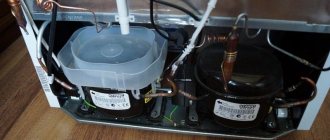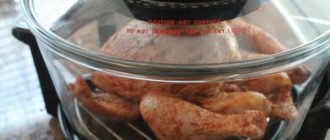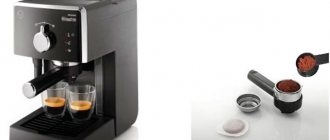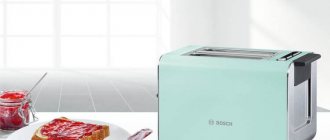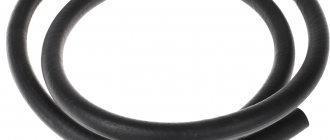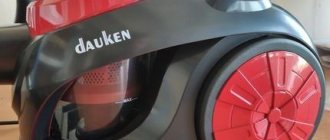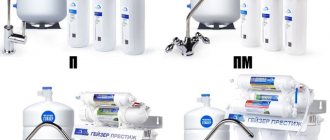Mine, mine
The least that manufacturers of household appliances can offer is easy-to-clean enamel and grease filters. The oven walls are coated with smooth, non-porous Easy To Clean or Granit Email enamel. All dirt can be easily wiped off by hand with a damp sponge. It is necessary to wash the oven after each use to prevent dirt from burning. It is best to do this with a soft sponge, liquid cleaning agent or without it, do not use powder - it can damage the coating. This type of cleaning is the most energy-intensive for those who cook and the cheapest for those who buy an oven. Prices for an oven with traditional cleaning start at RUB 7,000.
Methods for cleaning the oven
Cleaning the oven requires special attention. To facilitate this process, a huge variety of detergents have been developed. But oven cleaning products must not only effectively remove burnt grease, but also be safe for delicate women’s hands. It is this last condition that causes many problems. After all, a liquid that can dissolve fats has a harmful effect on both the skin of the hands and nails. In addition, cleaning solutions can cause an allergic reaction.
Using a covered container or roasting pan for cooking helps reduce fat splattering. But what if this is impossible? Oven manufacturers themselves help solve this problem. Modern models include coatings and devices that make cleaning equipment easier. This may include:
- Easy to clean enamel;
- Enamel with catalyst;
- Pyrolysis.
She cooks herself, she cleans herself.
Unlike the previous enamel, enamel for catalytic cleaning is porous and rough to the touch, but causes much fewer problems with cleaning. It is porous for a reason. It is these pores that absorb contaminants, and in them the decomposition of fat into carbon, water and organic residues occurs (catalysis). To clean the oven, you do not need to turn on a special mode, spending additional time on this. Cleaning occurs directly during food preparation. The decomposition of dirt begins at a temperature of 140° C, reaching a maximum at 200° C. Thus, after turning on the oven, it will be enough to wipe it a little.
Unfortunately, the catalytic purification system has quite significant drawbacks. Not all pollution breaks down into carbon and water at once. Large grease stains can disappear in just a few cycles of turning on the oven; if you are a pedant or don’t want to wait, wash by hand. Another disadvantage: over time, the enamel loses its catalytic properties - after 4-5 years you will have to change the internal panels, or turn them over if they are double-sided. Replacing panels will cost 2-4,000 rubles. Yes, and more. Not the entire inner surface of the oven is covered with enamel with catalytic properties. The bottom of the oven and the door, as before, will have to be washed by hand. Try to choose a model with a smooth door with a minimum number of joints so that you don’t have to clean every crevice.
By the way, ovens with catalytic cleaning from different companies practically do not differ from each other in terms of cleaning quality, because... They buy enamel from its manufacturers, and there are very few of them. Instead of special enamel (or together with it), the oven may have a grease filter. If the catalytic panels need to be changed periodically, then just wash the filter, you can even do it in the dishwasher. In this case, there should be no dishes in the dishwasher, because... food debris will get into the filter and it will stop working.
It is worth mentioning a type of catalysis – ecolysis. Ovens with such a cleaning system are produced, for example, by Siemens and Bosch. The ovens of these companies are covered with EcoClean enamel, on which fat decomposition occurs at a higher temperature - 270 ° C. And the Eco- prefix emphasizes the environmental friendliness of the process.
Ovens with a catalytic cleaning system are easy to use and relatively cheap, although more expensive than ovens with traditional cleaning. For example, Ariston offers 7 models of ovens with catalysis, the price varies from 16,000 to 36,000 rubles. All models are electric, gas only provide traditional cleaning. There are 8 ovens with pyrolytic cleaning. Let's compare two randomly selected ovens of the same Luce design: 7OFK 899E PX RU/HA with pyrolysis and FK 932 CX/HA with catalysis.
| 7OFK 899E PX RU/HA with pyrolysis | FK 932 CX/HA with catalysis | |
| Number of cooking programs | 10 | 8 |
| Oven capacity | 62l | 58l |
| Electronic timer | No | Yes |
| B-B-Q | Yes | No |
| Automatic baking | Yes | No |
| Simultaneous preparation of several dishes | No | Yes |
| Grill | No | Yes |
| Automatic bread preparation | Yes | No |
| Defrosting | No | Yes |
| Deep baking tray | 1 PC | No |
In general, there are few differences. Ovens with pyrolytic cleaning have a more powerful protection system, because... cleaning occurs at very high temperatures. The oven is equipped with triple glass, door and control panel locking.
Burn, burn clearly
Since we have given an example of an oven with pyrolytic cleaning, we will tell you more about it. Pyrolysis is the burning of fat and other contaminants at a very high temperature - 500° C. That is why the oven needs reliable protection against overheating and accidental opening of the door.
The door is locked until the temperature inside reaches 200° C. Triple glass protects the outer part of the door from overheating, but its temperature reaches 90° C - you can get burned. The oven body is made of steel, capable of withstanding repeated strong heating (remember about 500° C?) without deforming. To ensure that the side walls of the kitchen furniture in which the oven is installed do not warp from the high temperature or, God forbid, ignite, an additional cooling system for the outer surface is installed in it.
In the process of burning contaminants, an unpleasant odor is formed - an additional air purification system is needed: smoke removal directly from the oven into the ventilation; there is a special hole in the oven for this. And when various sauces burn, even toxic gases can be released (God, what are we eating) - special catalytic filters do not allow them to leave the oven. The enamel covering the inner surface of the oven should also not change its properties (not darken, for example).
To clean the oven, you must specifically turn it on. The cycle takes from 90 to 150 minutes, depending on the degree of contamination. When choosing an oven, please note that you can vary the cleaning time - this will save energy.
Of course, an oven made of such durable materials and equipped with such a powerful cleaning system cannot be cheap. Minimum price 18,000 rubles - Ariston F 1039GP.1 IX. Smeg offers ovens with pyrolytic cleaning from RUB 45,000.
Hydrolysis
As the name suggests, hydrolysis is cleaning the oven using water. About half a liter of water (sometimes with a cleaning agent) is poured into a baking tray, and the oven is turned on for half an hour at a temperature of 50 ° C - 90 ° C. Steam and cleaning agent soften dirt, and they are quite easy to remove with a cloth. Strictly speaking, hydrolysis cannot be called self-cleaning of the oven, because all the main work will have to be done by you - removing fat from the surface, albeit softened. Naturally, hydrolysis is effective only if the food remains have not had time to dry out.
Let's try to figure out which method is more effective
| Pyrolysis | Catalysis | Hydrolysis | |
| Oven cost | High | Average | Low |
| The need to additionally turn on the oven | Eat | No | Eat |
| Cleaning the oven manually | No | Eat | Eat |
| Energy consumption during cleaning process | High | Average | Low |
| Frequency of use | Rarely, due to contamination | After each use of the oven | After each use of the oven |
| Risk of getting burned | Eat | No | No |
| Raising the temperature in the kitchen | Eat | No | No |
| Availability of telescopic guides for baking sheets | Not available on all models | Eat | Eat |
Of course, each cleaning method has its pros and cons. If you don’t want to manually clean every joint inside the oven (catalysis still cannot completely remove dirt), choose an oven with pyrolytic cleaning, and don’t let the additional energy costs bother you. On average, electricity consumption per hour of operation is 3-4 kW, that is, 3 hours of pyrolysis will cost about 15-20 rubles, and no manual work!
One of the advantages of catalytic cleaning is that even a gas oven can have it. Electricity consumption is significantly lower, but the door and bottom of the oven still need to be washed manually, and the catalytic panels must be changed periodically.
Even manufacturers of household appliances cannot decide which cleaning option is better. For example, Gaggenau and Miele use pyrolytic cleaning on top oven models, while Neff and Kuppersbusch use catalytic cleaning. When choosing a cleaning method, you can be guided by the following recommendations (from Miele): if you use the oven once a week, catalysis is enough; if more often, pyrolysis is needed, because it is more effective.
Which oven cleaning is better: catalytic or hydrolysis?
As mentioned above, hydrolysis is a cleaning method using water vapor, and with a catalytic system, surfaces get rid of plaque and carbon deposits due to the characteristics of the panel coating.
Both methods are used not only in electric, but also in gas units, and this is a plus.
Continuing the comparative analysis, we can say that hydrolysis saves money (there is no need to purchase cleaning agents), and the catalytic method saves physical effort when washing surfaces, since it neutralizes grease. In addition, the catalytic panels will have to be replaced over time.
Related article: Which glue to choose for scrapbooking: main types for work
Which method is better is up to the hostess to decide; in this situation, it all depends on personal preferences.
You might be interested in:
Oven with microwave function (microwave) - Oven with microwave function - features, principle of operation, choice, reviews
Installation and connection of the oven - Description of the installation process and connection of the built-in oven
Pyrolytic oven cleaning - Operating principle, features, advantages and disadvantages of using pyrolytic oven cleaning
Oven - principle of operation - All about ovens - types, principle of operation, selection, repair, maintenance, prices, reviews, connection.
Page tags: which oven cleaning is better, catalytic oven cleaning, pyrolytic oven cleaning, oven cleaning methods, cleaning system
Catalytic purification
Surely many have heard about the presence of catalysis in the oven. Equipment with a similar function has a slightly rough internal enamel coated with a “porous” coating (a striking example is the Electrolux EOB93434AK model). These cells contain a catalyst - a chemical substance that burns fatty contaminants at temperatures up to 250°C. It is worth noting that the bottom and doors of the equipment are not covered with catalysis, so you will have to clean the dirt from them yourself.
What does catalytic oven cleaning mean and how to activate it? The process itself is the breakdown of fat molecules. Moreover, during this action you can safely continue to cook meat or bake fish. Splashes of fat from food that settle on the walls will immediately turn into soot. At the end of cooking, just wipe it with a cloth.
The cleaning system starts simultaneously with the equipment being turned on, which saves energy on additional equipment operation.
In addition, the list of its advantages:
- Long service life - panels with catalysis will last at least 5 years. The line of ovens also includes options with double-sided panels.
- Affordable price - the presence of a catalysis function in the oven does not affect the cost of the equipment at all.
- The versatility of the panels - if after years of service the panel ceases to perform its tasks, it can be easily replaced with a new one. Service centers provide not only consumables, but also installation services.
Similar technology can be used in electric and gas ovens. The operating principle of the system will be completely identical.
Interesting article on the topic: Electric or gas oven: 5 selection criteria
The presence of catalytic oven cleaning means that this equipment does not require additional costs or effort to maintain it in order.
But there are small disadvantages to this idyll:
- the technology does not clean very strong fatty contaminants the first time;
- If sugar or dairy products get on the surface, the panel will lose its properties.
Having understood what catalytic oven cleaning is and what the process itself means, you can safely purchase equipment with this function. Fortunately, the range of models on the market is huge.
